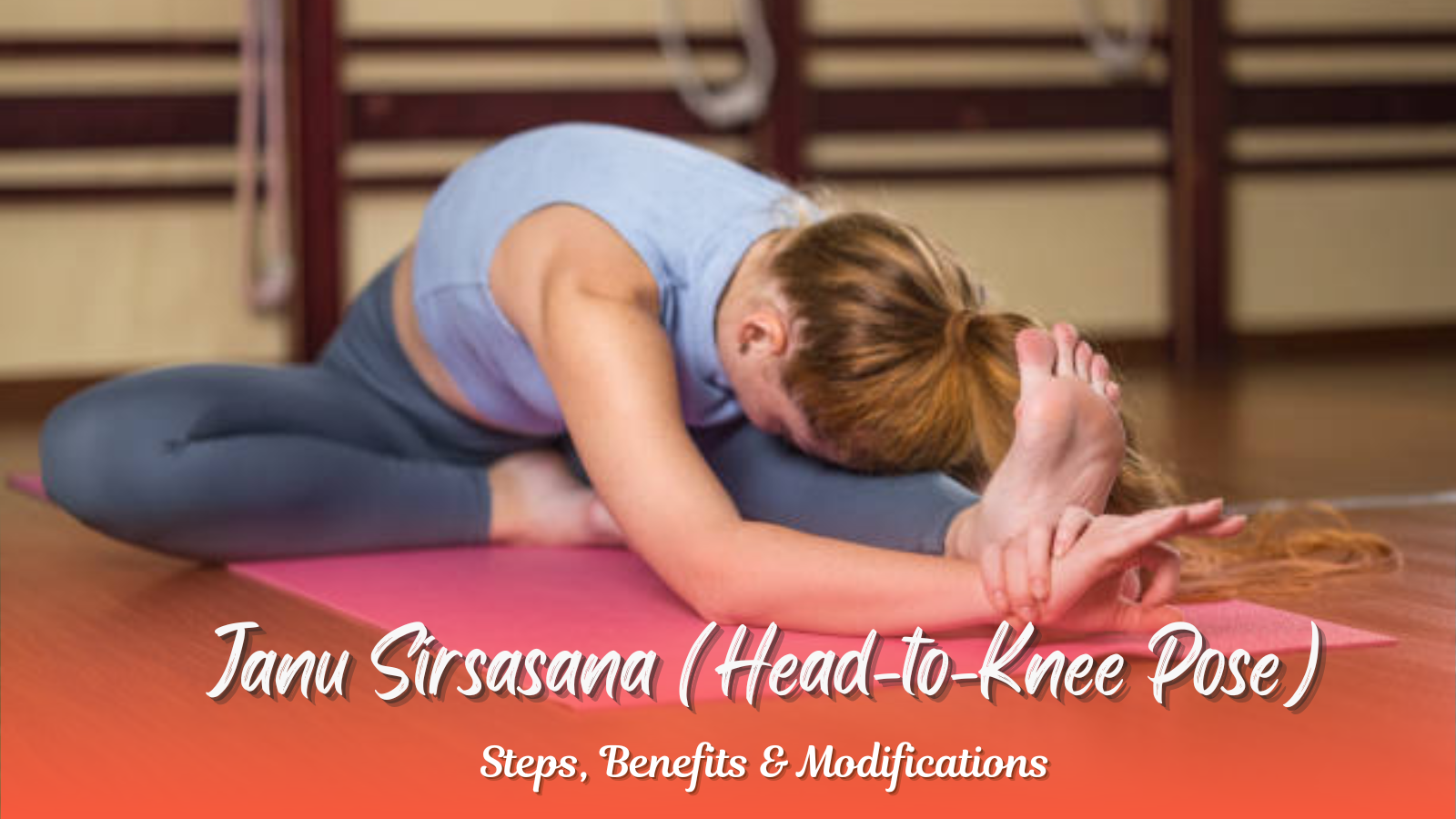Janu Sirsasana (Head-to-Knee Pose): Steps, Benefits & Modifications
What is Janu Sirsasana (Head-to-Knee Forward Bend)?
Janu Sirsasana or Head-to-Knee Pose is a seated asana that provides stretching, flexibility, and a lot of awareness. The Sanskrit name, “Janu Sirsasana”, can be divided into two parts where “Janu” is an abbreviation of “knee”, and “Sirsasana” refers to head or the head-to-knee pose. It is forward bend as the one leg stretched straight in which the other folded back, resting the foot near the inner thigh of the outstretched leg. In this asana, the body folds forward, bringing the head toward the knee, hence the name.
Sanskrit Meaning:
- “Janu” = Knee
- “Sirsa” = Head
- “Asana” = Pose/Posture
Janu Sirsasana, or the head-to-knee posture, is performed with great frequency in hatha yoga sequences. These sequences stretch the hamstrings, groin, and lower back, ensuring one feels good overall, improving their flexibility and even creating an element of relaxation. This asana proves very beneficial to those who wish to enhance their physical well-being. Thus, let’s uncover the step-by-step procedure for Janu Sirsasana, benefits of janushirasana, janu sirsasana steps, janu sirsasana sequence and what precautions one needs to exercise while doing it.
How to Do Janu Sirsasana (Step-by-Step Guide)
Step 1: Pre-warming the Body
Start by ensuring that your body is ready. Warm up the muscles with stretching the hamstrings, hips, and back. This is especially useful for those poses, Downward Dog, Forward Fold, or Cat-Cow.
Step 2: Initial Position
Sit down on the floor with your straight legs extended in front of you. Your spine is lengthened and open, and your shoulders are pressed back. Then engage your thighs to press down using your feet so that your legs are engaged.
Step 3: Fold One Leg IN
Bend your right leg, bringing the sole of your right foot toward your left inner thigh. The heel of the bent leg should be close to the groin area and the foot flexed. Make sure your right knee points out toward the floor, and your left leg stays straight on the mat.
Step 4: Extend the Spine
Inhale and lengthen your spine up to sitting upright. Reach your arms up over your head and engage your inner core.
Step 5: Fold Forward
Fold forward from the hips as you exhale, keeping your spine long and straight. Reach your hands toward the toes of your extended leg. You will want to draw your head toward the knee.
If you cannot touch your foot, do not worry. Enclose your arms around the leg as far as possible – even the shin, ankle, or foot – and expand your chest without allowing your upper body to sink in.
Step 6: Hold the Stretch
Hold for 30 seconds to 1 minute, breathing deeply. Be careful not to over-stretch and strive to deepen the stretch as you breathe out slowly bringing your chest toward your thigh.
Step 7: Come out of the Pose
Straighten your arms slowly and breathe inwards when getting up as you stretch your backbone. Your leg should straighten also as you go back to the sitting posture.
Step 8: Side Repetition
Do it on the opposite side also. This way it will be helpful for both the sides to become balanced.
Advantages of Janu Sirsasana or Key Benefits of Janu Sirsasana
Janushirshasana has many physical, mental, and emotional benefits. Let’s break janusirsasana benefits or janushirasana benefits down:
1. Stretches the Hamstrings and Back
It mainly stretches the hamstrings, which are tight from sitting or lack of flexibility. The forward fold also stretches the lower back and spine. With regular practice, this pose will improve your overall flexibility and mobility.
2. Relieves Tension in the Lower Back
The deep forward bend in Janu Sirsasana loosens the lower back pain, which is usually caused by a long period of sitting or improper posture. It is a mild relief to the lumbar spine and promotes healthy spines.
3. Aids Digestion
The soft compression on the abdomen while folding forward in Janu Sirsasana stimulates the digestive organs. It facilitates better digestion and can help to relieve constipation.
4. Calms the Mind and Reduces Stress
It is also known as forward fold. Forward folding calms the nervous system. The forward bend reduces stress and anxiety since it places compulsion on relaxation and deep breath. This asana establishes mental clarity and awareness.
5. Reduces flexibility and mobility
Regular practice of Janu Sirsasana helps to enhance flexibility, particularly in the hamstrings, groins, and lower back. It also facilitates hip mobility, which is very helpful in everyday activities and other yoga postures.
6. Stretches the Inner Thighs
Deep stretch to the inner thighs or adductors by bending one leg gives flexibility in these areas. This is essential for maintaining the health of the hip and the general movement of the lower body, respectively.
7. Stretches the Kidneys and Liver
The anterior flexion of the asana stretches the abdominal organs, particularly the kidneys and the liver. Such stretching enhances the functionality of the organs and also detoxifies the body.
8. Improves Posture
Stretching the vertebral column makes one’s posture improved and flexible at the back due to flexibility of the hamstring. Moreover, it provides a person with more erect and confident stance while sitting or standing.
9. Improves Mental Focus and Clarity
This pose can be used to focus on the breath and balance, which can improve mental clarity and concentration. Folding forward requires mental focus, which improves concentration and mental discipline.
10. Relieves Menstrual Discomfort
It may ease out menstrual cramp and pain because of the gentle abdominal massage that will be applied by this pose. It may also give relaxation, which can alleviate pains during menstruation and might help adjust menstrual cycle.
Precautions during Janu Sirsasana
Even if it has various janu sirsasana benefits, this must be practiced well and with utmost care to avoid injury. Here are the janu sirsasana precautions in practicing this pose:
1. Avoid This Pose If You Have a Back Injury
In case you had ever had some problems with the back, or you have an issue in the back now, you should not practice this pose or do its modified version. Any style of yoga should be practiced only under the guidance of a healthcare provider if you are suffering from the back issue.
2. Long Spine
Maintain the entire length of your spine. Do not bend forward and arch your back. Attempt to bend forward from the hips, rather than the lower back.
3. Do Not Force the Forward Bend
Never force yourself while performing the forward bend. It is perfectly okay if you are unable to reach your feet. It is much more important that you maintain the length of the spine and gently sink into the stretch.
4. Pregnant Women Should Avoid This Pose
This pose requires a deep forward fold, and pregnant women should avoid it. It would put pressure on the abdomen and the baby. Always check with a healthcare professional to look for safe alternatives when pregnant.
5. Don’t Overstretch
Overstretching the muscles and ligaments can create tension if one stretches too much. Be sure to heed your body and stretch as far only as you feel safe without straining.
Janu Sirsasana Variations & Modifications for Beginners
There are many variations of Janu Sirsasana that can help you deepen the stretch, modify it for beginners, or hold it statically:
1. Parivrtta Janu Sirsasana (Revolved Head-to-Knee Pose)
Parivrtta janu sirsasana benefits involves twisting on the torso while reaching for the foot. This helps in giving a bit deeper stretch to the spine, shoulders, and hips; therefore, digestion is activated simultaneously.
2. Dandayamana Janu Sirsasana-Stand Head-to-Knee Pose
Here you stand on one leg, doing the forward bend identical to the previous variation. This helps engage your core and balance better.
3. Janu Sirsasana with a Strap
For those who are beginners or not very flexible, a yoga strap can be used to help reach the foot. Wrap the strap around the foot and use it to guide your body into the fold.
4. Modified Janu Sirsasana for Beginners
For beginners, the posture may be modified by sitting on a blanket or block to elevate the hips and make it easier to fold forward. It can be practiced with a little bend in the extended leg to decrease the intensity as well.
5. Janu Sirsasana with Elevated Foot
You can also take it further and put a bolster or a pillow under the foot of the stretched leg. Janushirasana images enhances the stretch at the hip flexors and provides an enhanced folding forward.
Integrating Janu Sirsasana into Your Yoga Routine
Janu Sirsasana is a powerful, accessible yoga pose that offers several benefits for both the body and the mind. Improved flexibility, release of tension, and a soothing effect on the nervous system are some of the ways it can improve your well-being in general. This requires care in practice, especially at the start, and a willingness to listen to your body. With time and consistency, Janu Sirsasana can become a powerful addition to your yoga practice.
Whether you’re a new yogi or an advanced practitioner, adding Janu Sirsasana to your practice will enhance flexibility, postural awareness, and mental acuity. With all yoga, listen to your body and use mindful breathing as you’d do with any other asana to excel in this beautiful transformation.
Note: If you want to deepen your yoga practice and gain more insights, you can enroll in a 200-hour yoga teacher training course in Rishikesh or look for yoga teacher training schools in Rishikesh. These courses are excellent for deepening your knowledge of poses such as Janu Sirsasana and other yoga practices.
Janu Sirsasana Common Questions
1. How to do Janu Sirsasana?
Janu Sirsasana is a simple yet effective sequence that stretches your hamstrings, hips, and spine. Here’s a step-by-step breakdown of the pose:
Step 1: Begin seated
Sit on the floor with your legs extended straight in front of you. Keep your spine long, shoulders relaxed, and legs active.
Step 2: Bend one leg
Bend your right knee, bringing the sole of your right foot toward your left inner thigh. The right knee should point outward towards the floor, and the left leg remains straight.
Step 3: Lengthen the Spine
Inhale and extend your spine upwards, sitting tall and engaging your core muscles. Reach your arms overhead, and align your body with the extended leg.
Step 4: Fold Forward
Breathe out and fold forward from your hips, reaching your hands toward the toes of your extended leg. As you bring your chest toward your thigh, keep your spine long.
Step 5: Hold the Pose
Hold the pose for about 30 seconds to 1 minute, breathing deeply and maintaining a steady focus. Gradually deepen the stretch with each exhale.
Step 6: Release and Repeat
To release the pose, slowly return to the seated position. Repeat the same sequence on the opposite side.
This step-by-step approach helps you perform the pose effectively and safely while gaining all the benefits.
2. Who Should Not Do Janu Sirsasana?
While Janu Sirsasana is beneficial for most people, there are certain groups who should avoid this pose or practice it with caution. These include:
People with Back Injuries:
Any severe back issues or herniated disc should steer clear of this pose, forward fold. Anyone with a back injury should strictly consult a healthcare provider if they wish to try this pose.
Pregnancy:
Women in their late stages of pregnancy must avoid deep forward bends like Janu Sirsasana. It may tighten the pelvis area that presses the abdomen in an unnecessary way and is not conducive during pregnancy.
Individuals with Hamstring Injuries:
In case of hamstring injury or strain, it is advisable not to practice this asana or modify the asana if one needs to, because bending forward may trigger the injury.
Knee Injuries
One with a knee injury or who suffers from any other condition such as a ligament damage or arthritis, it is essential to practice the pose carefully because bending one knee so much will strain the knee joint.
Those with Little Flexibility:
While Janu Sirsasana is a great flexibility builder, if you have poor flexibility, proceed with the utmost caution. It is better to use blocks or straps for support instead of forcing the fold.
3. What is the Other Name for the Pose?
Other Names for Janu Sirsasana
Janu Sirsasana is commonly known as Head-to-Knee Pose in English because in this pose, one bends forward toward the extended leg’s knee, with the aim of bringing the head to the knee. Janu shirshasana information in marathi gives a simple description of the movement of the pose, where your head is aimed toward the knee of the extended leg.
4. What Are the Benefits of Janu Sirsasana?
Janu Sirsasana offers a variety of benefits for both the body and mind:
Stretches Hamstrings and Lower Back:
The major benefit of Janu Sirsasana is that it deeply stretches the hamstrings, lower back, and spine. With constant practice, one can achieve greater flexibility and lesser lower back pain.
Digestive Improvement:
Gentle compression of the abdomen helps stimulate the digestive organs and thus better digestion and less constipation.
The nervous system calms down through Janu Sirsasana. It provides relaxation and decreases stress. This pose is a good symptom relief for anxiety.
Helps with Good Posture:
This stretch of the spine improves flexibility. This asana lengthens the back, allowing a person to maintain an erect posture.
It calms down the mind. Being a head-to-knee forward bend, Janu Sirsasana can relieve a person of any form of stress or tension while at the same time improving their mental clarity in general.
5. How can I modify this pose for a beginner?
For a beginner or one with minimal flexibility, it can be slightly modified for easier performance. Here are some helpful modifications:
Use Props:
Put a yoga block or pad under your hips to raise them off the ground a bit and reduce the intensity of this forward bend.
Keep the Knee Bent:
If you cannot straighten the extended leg at first, bend it a little to make the stretch less intense and avoid over-stretching the muscles.
Use a Strap:
For those who cannot reach their toes, using a janu sirsasana yoga strap around the foot can help. Hold the strap with both hands and gently pull yourself forward.
FAQs on Janu Sirsasana
1. Which disease is cured by Janu Sirsasana?
Janu Sirsasana helps improve digestion, reduce anxiety, and relieve back pain. It also stimulates the kidneys and liver, promoting detoxification.
2. Who should avoid Janu Sirsasana?
Avoid this pose if you have severe knee, hip, or spinal injuries. Pregnant women should consult a yoga instructor before attempting forward bends.
3. What chakra is activated by Janu Sirsasana?
This pose activates the Root Chakra (Muladhara) and Sacral Chakra (Svadhisthana), improving grounding, stability, and energy balance.
4. Why is Janu Sirsasana important in yoga?
It enhances spinal flexibility, digestion, and mental clarity, making it an essential part of Hatha & Ashtanga yoga sequences.
Final Thoughts: Why Janu Sirsasana Should Be in Your Yoga Practice
✅ Enhances flexibility & mobility
✅ Stimulates digestion & detoxification
✅ Boosts mental focus & stress relief
✅ Supports spinal health & lower back strength
If you really want to dive deeply into the transformative power of yoga, consider attending a 200 Hour Yoga Teacher Training at an established Yoga Gurukul in Rishikesh. The program will give you the best yoga and meditation training but teaches you to live a more centered, mindful life. You shall discover the depth of your practice in a truthful and nurturing environment, be given the confidence and tools to succeed in all aspects of your life.


